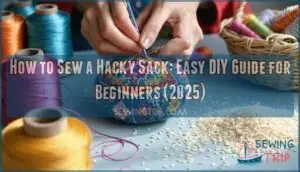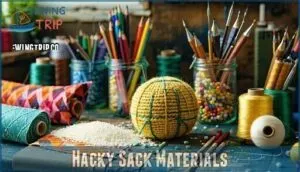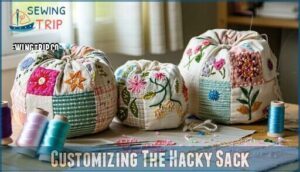This site is supported by our readers. We may earn a commission, at no cost to you, if you purchase through links.
 To sew a hacky sack, start by choosing a sturdy fabric like denim or canvas and a filling such as rice or plastic pellets.
To sew a hacky sack, start by choosing a sturdy fabric like denim or canvas and a filling such as rice or plastic pellets.
Cut out two identical circles or squares, about 4 inches wide. Place the pieces together with the inside facing out, then sew around the edges, leaving a small gap.
Turn it right side out using the gap. Add your chosen filling, making sure it’s firm but not bursting at the seams. Sew the opening shut with tight stitching.
For extra durability, use a double-thread needle. Want it personalized? Experiment with embroidery, colors, or unique patterns!
Table Of Contents
Key Takeaways
- Choose durable fabrics like denim or canvas and use sturdy thread for long-lasting durability.
- Sew small, tight stitches to prevent any filling from escaping, and double-thread for extra strength.
- Fill the hacky sack about 90% full with materials like rice, plastic pellets, or sand for the right weight and feel.
- Customize your hacky sack with unique fabrics, embroidery, or decorative stitching to make it stand out.
Hacky Sack Materials
You’ll need three main types of materials to create your hacky sack: durable fabric like cotton or nylon, filling materials such as rice or plastic pellets, and basic sewing tools including thread and needles.
Getting the right materials from the start guarantees your finished hacky sack will last through countless games and provide the perfect weight and bounce for playing.
The right materials ensure your hacky sack survives endless games with perfect weight, bounce, and durability for top-notch playability.
Choosing The Right Fabric
The right fabric makes or breaks your DIY hacky sack project.
You’ll want materials that balance durability with comfort for countless kicks and catches.
Consider these top fabric choices for sewing success:
- Polar fleece – Forgiving for beginners with excellent stitch compatibility
- Synthetic suede – Perfect material weight with superior texture options
- Cotton twill – Outstanding fabric durability and color fastness for long-lasting play
It’s also available to purchase polar fleece for other sewing projects.
Selecting Filling Materials
Now that you’ve picked your fabric, let’s talk filling options. Your hacky sack filling determines how it feels and plays.
Rice and lentils work great for beginners. They’re cheap and give good weight. Plastic pellets bounce more but cost extra. Sand creates heavier bags that stall better.
Plastic pellets bring the bounce, sand adds stability, and rice offers budget-friendly weight—choose your perfect hacky sack filler and play on!
You can find various filling options online.
| Filling Type | Best For |
|---|---|
| Rice/Lentils | Budget-friendly beginners |
| Plastic Pellets | Lightweight bounce play |
| Sand | Heavy stalling moves |
| Metal Pellets | Advanced deliberate style |
Consider filling weight and material texture when choosing. Rice offers decent filling durability at low cost. Plastic pellets reduce environmental impact compared to inorganic fillers. Each option changes your hacky sack’s personality completely.
Gathering Essential Tools
Now you’ll need the right tools to bring your hacky sack to life.
Needle selection matters—choose a sturdy needle that matches your fabric thickness.
Sharp scissors make clean cuts through materials.
Quality thread types like polyester offer durability.
Filling funnels prevent messy spills when adding rice or pellets.
Basic measuring tools guarantee consistent sizing for professional results.
Sewing a Hacky Sack
Now that you’ve gathered your materials, you’ll start the actual construction process by preparing your fabric strips and sewing them together with small tight stitches.
You’ll create the basic hacky sack shape by carefully joining the fabric pieces while leaving a small opening for filling and then turning the completed shell right side out, which involves a process of carefully sewing them together.
Preparing The Fabric Strips
Cut your fabric into strips about 2-3 inches wide for ideal hacky sack sewing.
Sharp scissors guarantee clean edges that won’t fray during stitching techniques.
Color combinations add personality to your fabric scraps project.
Each strip should measure roughly 6 inches long.
Edge finishing isn’t necessary but helps prevent unraveling.
To get the best results, consider using specialized cutting tools.
This sewing tutorial works with cotton, denim, or canvas fabric.
Sewing The Strips Together
With your fabric strips ready, thread your needle with double-strength polyester thread.
This hacky sack sewing project requires precise stitch tightness to prevent filling from escaping later.
Here’s your step-by-step sewing tutorial:
- Start with proper needle size – Match your needle to fabric thickness for smooth penetration
- Create small, uniform stitches – Keep stitches close to edges for maximum edge security
- Face fabric’s nice side inward – This sewing technique guarantees clean finished seams
- Experiment with fabric combinations – Mix textures or create stripe patterns for visual appeal
- Maintain consistent stitch spacing – Even stitches provide durability and professional appearance
Leaving a Small Opening
Stopping your stitching before completing the seam creates the essential filling access you’ll need later.
Leave a one-inch opening along your hacky sack’s edge – this opening size allows easy rice insertion while maintaining secure closure potential.
Mark this spot with a pin to avoid accidental sewing.
Proper stitch reinforcement around the opening prevents small holes that cause annoying leaks during play, ensuring a secure closure and maintaining the integrity of your hacky sack.
Turning The Hacky Sack Right Side Out
After completing your seam work, it’s time to flip your hacky sack inside out. This step reveals the final shape while protecting fabric integrity from future wear.
Here’s how to turn it properly:
- Gently push one corner through the opening to start the flip
- Work slowly to avoid seam stress and potential tears
- Pull fabric through opening carefully maintaining even distribution
- Check that all edges are fully turned for achieving roundness
By following these steps, you ensure that your hacky sack is properly flipped and ready for use, with its fabric integrity protected.
Filling The Hacky Sack
Now you’ll add the filling that gives your hacky sack its weight and bounce.
You’ll need about one-third cup of rice or similar material to create the perfect feel for kicking and catching.
Choosing The Right Filling Amount
Your weight preference determines the perfect hacky sack filling amount.
Fill your homemade hacky sack about 90% full for ideal bounce factor.
Rice alternatives like plastic pellets offer different bean density options.
Smaller pellet size creates more pop while larger materials provide better stall control.
Follow these filling instructions carefully – too much reduces bounce, too little makes kicks inconsistent.
The right balance transforms basic materials into playable perfection.
Using a Funnel for Easy Filling
A funnel makes filling your hacky sack much easier than pouring rice directly from a bag.
Choose a funnel size that fits your fabric opening without stretching it. If you don’t have a funnel, roll paper into a cone or cut the top off a plastic bottle.
These household materials work just as well for avoiding spillage during the filling process.
Distributing The Filling Evenly
After filling your homemade hacky sack, gentle shaking creates even weight distribution throughout the fabric. Proper filling density prevents dead spots that ruin gameplay.
Here’s how to achieve perfect feel and texture consistency:
- Shake gently – Roll the hacky sack between your palms to redistribute filling
- Massage corners – Work filling into all areas using your fingers
- Test bounce – Drop from waist height to check weight distribution
- Avoid clumping – Separate any bunched filling through the fabric
- Check stitches – Verify that filling doesn’t stress seam areas
Sealing The Opening Securely
After the filling’s evenly spread, secure the hacky sack by stitching the opening shut.
Use small, tight stitches for durability and leak prevention. Reinforce with knot tying or try glue alternatives like fabric adhesive.
Confirm the thread holds firmly to avoid spills during use. A durable closure guarantees your hacky sack stays intact, keeping all that filling in place, ensuring leak prevention.
Customizing The Hacky Sack
You can make your hacky sack stand out by adding personal touches like embroidery, unique fabrics, or beads.
These customizations enhance both the look and feel, making your creation truly one of a kind.
Adding Decorative Embroidery
Adding decorative embroidery can make your hacky sack one-of-a-kind.
Use embroidery floss and simple surface stitching patterns to enhance its look.
Experiment with bold color palettes or transfer embroidery designs for precision.
Pick a sharp needle suited to your fabric.
Embroidery isn’t just decorative—it’s your chance to leave a personal touch.
- Highlight patterns to match your style.
- Layer stitches for extra texture.
- Combine colors for playful effects.
Using Different Fabrics and Textures
Choose fabrics that balance durability and texture. Cotton blends are soft yet strong, while nylon adds flexibility.
Heavier materials affect weight, so stick to lightweight options.
Mix colors for vibrant combinations that pop. Consider stitch visibility—tight, neat stitching blends better with bold designs.
Play with textures like smooth vinyl or woven patterns to enhance your hacky sack’s unique, customized look, and consider bold designs for a more vibrant appearance, using lightweight options.
Adding Beads or Buttons for Visual Interest
You can personalize your hacky sack with beads or buttons to make it stand out.
Focus on Button Placement and Bead Size for appealing design. Consider Color Coordination to match fabrics.
Use sturdy Attachment Methods, like strong thread or glue, to guarantee Durability Testing doesn’t fail.
These decoration ideas add charm, showing crafting creativity through touchable customization.
Creating a Unique Design
You’ve explored embellishments; now focus on unique designs. Experiment with fabric combinations, stitch patterns, and color palettes to create something one-of-a-kind.
Bold color combinations or personal embellishments like embroidery can make your hacky sack stand out. Try unique shapes, like hexagons or patchwork circles, for added flair.
Design customization lets your creativity shine through every detail, making it truly yours.
Advanced Sewing Techniques
You can take your hacky sack projects to the next level by trying advanced sewing techniques that enhance durability and style.
Experiment with contrasting stripes, unique fabrics, and decorative stitching to create designs that stand out.
Using Contrasting Stripes for Texture
Stripes bring life to your hacky sack.
Mix bold and subtle color combinations for exciting visual effects.
Alternate stripe widths to create more depth.
Use stitch patterns that contrast nicely with your fabric choice.
Here’s how to craft striking stripes:
- Pick two or three fabrics that complement each other.
- Plan stripe widths before sewing.
- Use precise, tight stitches.
Experimenting With Different Fabric Types
Try lightweight cotton for a softer hacky sack or thicker nylon for durability.
The fabric’s texture impacts grip and playability.
Test weight variance with different materials like canvas or suede.
Verify stitch compatibility to prevent tearing.
Consider color fastness if dye runs during washing.
Each fabric choice changes how your hacky sack feels, moves, and lasts.
Incorporating Decorative Stitching
Decorative stitching adds flair to your hacky sack and makes it one-of-a-kind.
Use thoughtful stitch patterns, thread choices, and color combinations to complement the design. Focus on clean design placement for balance.
Experiment with embroidery or textured stitching techniques to enhance creativity.
- Add texture effects like raised stitches for depth.
- Use bold color threads to create contrast.
- Highlight seams with creative patterns.
Creating a Series of Hacky Sacks With Increasing Difficulty
Building from decorative stitching, create hacky sacks with increasing complexity.
Begin with simple designs for confidence, then explore advanced techniques.
Adjust weight progression, size variation, and stitch density for new challenges.
Test your skills with material complexity and shape experimentation.
Track your progress with this guide:
| Level | Size (Inches) | Filling Type | Material Used | Stitch Design |
|---|---|---|---|---|
| Beginner | 2-3 | Rice | Cotton Sock | Basic Single Stitch |
| Novice | 3.5 | Plastic Pellets | Cotton Yarn | Tight Stitch |
| Intermediate | 4 | Steel Pellets | Leather Patch | Cross Stitch |
| Advanced | 4.5 | Lentils | Felt Strips | Double Stitch |
| Expert | 5 | Mixed Beans | Denim | Decorative Pattern |
Experiment and master each step to improve your skills and create unique hacky sacks.
Frequently Asked Questions (FAQs)
What Type of Needle Should I Use for Sewing a Hacky Sack?
Pick a practical, pointy needle with a small eye for precise control.
Use a sharp needle for fabrics and a ballpoint needle for knits.
Make certain it’s strong enough to handle both thick and thin materials.
How Can I Make Sure the Filling Stays in the Hacky Sack?
Seal the hacky sack tightly using small, strong stitches.
Reinforce seams with double-threaded polyester thread for durability. Check for gaps before filling, and sew securely after.
Use a second layer or lining for extra protection.
What Are the Best Materials to Use for Making a Hacky Sack?
Use durable materials like cotton or nylon fabric for the cover and rice, beans, beads, or plastic pellets for filling.
These provide good weight and texture, ensuring your hacky sack stays sturdy during use.
Are There Any Special Techniques for Attaching the Strips Together?
You’ve got to think like a puzzle master.
Start by sewing narrow, tight, and precise stitches along the edges of each strip.
Align them evenly, and secure seams firmly so no filling escapes, this requires precise stitches to be effective.
What is the best filling for a hacky sack?
Filling matters most for balance and durability.
Rice, lentils, or plastic pellets work well, offering weight and flexibility.
Avoid dense or sharp items that might tear material.
Test weight until the hacky sack feels right.
Ensure the filling provides the necessary balance for optimal performance.
What materials are used in hacky sack?
Hacky sack materials include durable fabrics like cotton or nylon for the cover, and fillings such as rice, plastic pellets, or beans.
Add polyester thread, needles, and optional leather or vinyl for customization and strength.
How to make a Chinese hacky sack?
Crafting a Chinese hacky sack mirrors life’s balance—blending precision and artistry.
Sew layers of fabric into a pouch, fill with metal washers, then attach colorful feathers for charm.
Test its bounce before play.
What type of needle should I use for sewing a hacky sack?
Use a sharp, medium-sized needle that matches your fabric’s thickness.
For socks or stretchy materials, choose a curved or ballpoint needle.
Thicker materials like leather need heavier needles to avoid breaking while sewing.
How can I make sure the filling stays in the hacky sack?
Sew the edges tightly with small, consistent stitches, leaving no gaps.
Double-thread your needle for strength, and reinforce the opening after filling.
Test by squeezing to verify nothing escapes before final sealing.
What are the best materials to use for making a hacky sack?
Imagine building a tiny world in your hands; choose clean socks, durable yarn, or stretchy balloons.
Fill with rice, lentils, or beads.
Add snug stitches or layers to lock it all inside.
Conclusion
Now that you’ve mastered how to sew a hacky sack, the possibilities are endless.
From fabric choices to custom designs, every step lets you create something truly unique.
Focus on tight stitching and proper filling for durability. Take your time sealing the opening securely to prevent leaks.
Experiment with patterns, textures, or embroidery for a personal touch. With practice, crafting hacky sacks can become a fun and rewarding DIY hobby you’ll enjoy for years.
- https://www.nowfoods.com/
- https://en.wikipedia.org/wiki/Opportunism
- http://www.youtube.com/results?search_query=hacky+sack&oq=hacky+sack&gs_l=youtube.3..0l10.53.544.0.761.4.2.0.2.2.1.249.277.1j0j1.2.0...0.0...1ac.1.11.youtube.ki3hnXNT9pc
- https://sajou.fr/en/blog/decorative-traditional-embroidery-stitches-n178
- https://www.quora.com/What-can-you-use-to-stuff-a-Hacky-Sack

















